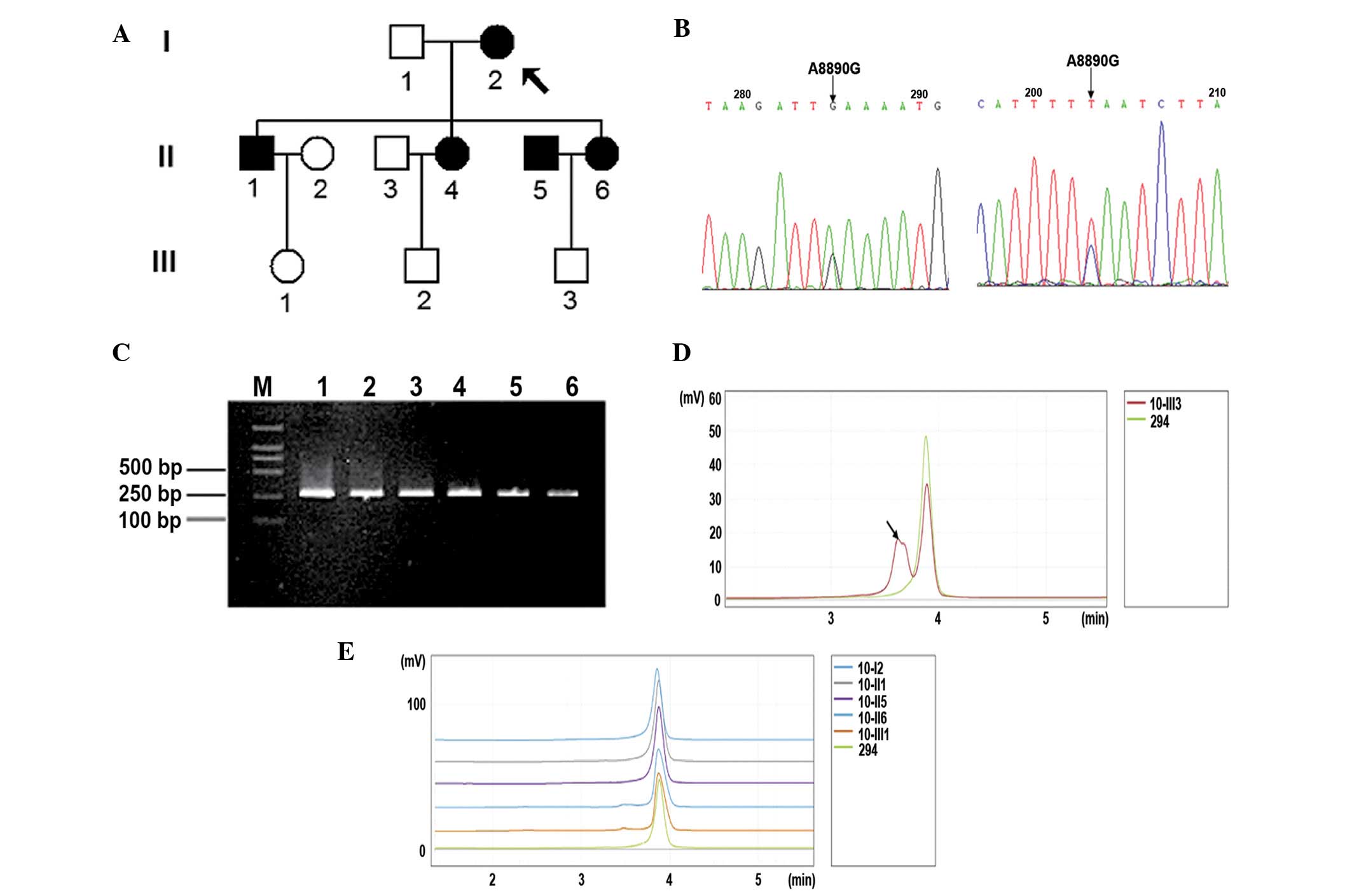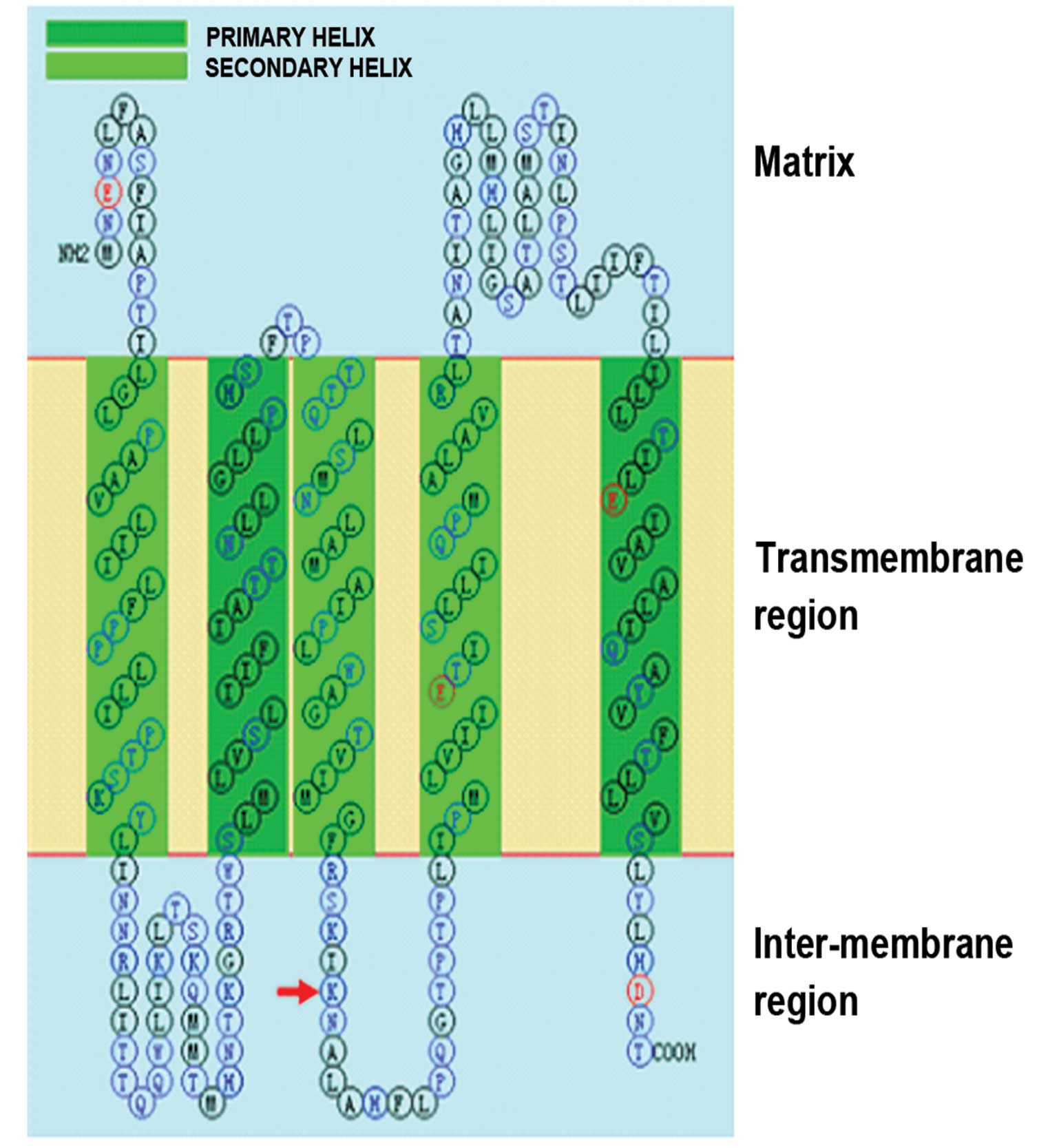|
1
|
Wilson FH, Hariri A, Farhi A, et al: A
cluster of metabolic defects caused by mutation in a mitochondrial
tRNA. Science. 306:1190–1194. 2004. View Article : Google Scholar : PubMed/NCBI
|
|
2
|
Ervin RB: Prevalence of metabolic syndrome
among adults 20 years of age and over, by sex, age, race and
ethnicity and body mass index: United States, 2003–2006. Natl
Health Stat Report. 5:1–7. 2009.PubMed/NCBI
|
|
3
|
Lim S, Shin H, Song JH, et al: Increasing
prevalence of metabolic syndrome in Korea: the Korean National
Health and Nutrition Examination Survey for 1998–2007. Diabetes
Care. 34:1323–1328. 2011.
|
|
4
|
Gu D, Reynolds K, Wu X, et al: Prevalence
of the metabolic syndrome and overweight among adults in China.
Lancet. 365:1398–1405. 2005. View Article : Google Scholar : PubMed/NCBI
|
|
5
|
Yi Z, Jing J, Liu X-Y, et al: Prevalence
of the metabolic syndrome among rural original adults in NingXia,
China. BMC Public Health. 10:1402010. View Article : Google Scholar : PubMed/NCBI
|
|
6
|
Alberti KG, Zimmet P and Shaw J; IDF
Epidemiology Task Force Consensus Group. The metabolic syndrome - a
new worldwide definition. Lancet. 366:1059–1062. 2005. View Article : Google Scholar : PubMed/NCBI
|
|
7
|
Janssen I, Katzmarzyk PT and Ross R: Waist
circumference and not body mass index explains obesity-related
health risk. Am J Clin Nutr. 79:379–384. 2004.PubMed/NCBI
|
|
8
|
Ordovas JM: Nutrigenetics, plasma lipids
and cardiovascular risk. J Am Diet Assoc. 106:1074–1081; quiz 1083.
2006. View Article : Google Scholar : PubMed/NCBI
|
|
9
|
Frederiksen L, Brødbaek K, Fenger M, et
al: Comment: studies of the Pro12Ala polymorphism of the PPAR-gamma
gene in the Danish MONICA cohort: homozygosity of the Ala allele
confers a decreased risk of the insulin resistance syndrome. J Clin
Endocrinol Metab. 87:3989–3992. 2002.PubMed/NCBI
|
|
10
|
Bennet AM, Prince JA, Fei GZ, et al:
Interleukin-6 serum levels and genotypes influence the risk for
myocardial infarction. Atherosclerosis. 171:359–367. 2003.
View Article : Google Scholar : PubMed/NCBI
|
|
11
|
Murase Y, Yagi K, Katsuda Y, et al: An
LMNA variant is associated with dyslipidemia and insulin resistance
in the Japanese. Metabolism. 51:1017–1021. 2002. View Article : Google Scholar : PubMed/NCBI
|
|
12
|
Steinle NI, Kazlauskaite R, Imumorin IG,
et al: Variation in the lamin A/C gene: associations with metabolic
syndrome. Arterioscler Thromb Vasc Biol. 24:1708–1713. 2004.
View Article : Google Scholar : PubMed/NCBI
|
|
13
|
Juo SH, Lu MY, Bai RK, et al: A common
mitochondrial polymorphism 10398A>G is associated metabolic
syndrome in a Chinese population. Mitochondrion. 10:294–299. 2010.
View Article : Google Scholar
|
|
14
|
Palmieri VO, De Rasmo D, Signorile A, et
al: T16189C mitochondrial DNA variant is associated with metabolic
syndrome in Caucasian subjects. Nutrition. 27:773–777. 2011.
View Article : Google Scholar : PubMed/NCBI
|
|
15
|
Anderson S, Bankier AT, Barrell BG, et al:
Sequence and organization of the human mitochondrial genome.
Nature. 290:457–465. 1981. View
Article : Google Scholar : PubMed/NCBI
|
|
16
|
Yakes FM and Van Houten B: Mitochondrial
DNA damage is more extensive and persists longer than nuclear DNA
damage in human cells following oxidative stress. Proc Natl Acad
Sci USA. 94:514–519. 1997. View Article : Google Scholar : PubMed/NCBI
|
|
17
|
Soejima A, Inoue K, Takai D, et al:
Mitochondrial DNA is required for regulation of glucose-stimulated
insulin secretion in a mouse pancreatic beta cell line, MIN6. J
Biol Chem. 271:26194–26199. 1996. View Article : Google Scholar : PubMed/NCBI
|
|
18
|
Nishio Y, Kanazawa A, Nagai Y, et al:
Regulation and role of the mitochondrial transcription factor in
the diabetic rat heart. Ann NY Acad Sci. 1011:78–85. 2004.
View Article : Google Scholar : PubMed/NCBI
|
|
19
|
Nisoli E, Clementi E, Carruba MO, et al:
Defective mitochondrial biogenesis: a hallmark of the high
cardiovascular risk in the metabolic syndrome? Circ Res.
100:795–806. 2007. View Article : Google Scholar : PubMed/NCBI
|
|
20
|
Rieder MJ, Taylor SL, Tobe VO, et al:
Automating the identification of DNA variations using quality-based
fluorescence re-sequencing: analysis of the human mitochondrial
genome. Nucleic Acids Res. 26:967–973. 1998. View Article : Google Scholar : PubMed/NCBI
|
|
21
|
Zimmet P, Alberti KG, Kaufman F, et al:
The metabolic syndrome in children and adolescents. Lancet.
370:1541–1542. 2007.
|
|
22
|
Zimmet P, Alberti KG, Kaufman F, et al:
The metabolic syndrome in children and adolescents-an IDF consensus
report. Pediatr Diabetes. 8:299–306. 2007. View Article : Google Scholar : PubMed/NCBI
|
|
23
|
Mueller EE, Eder W, Ebner S, et al: The
mitochondrial T16189C polymorphism is associated with coronary
artery disease in Middle European populations. PLoS One.
6:e164552011. View Article : Google Scholar : PubMed/NCBI
|
|
24
|
van den Ouweland JM, Lemkes HH, Ruitenbeek
W, et al: Mutation in mitochondrial tRNA(Leu)(UUR) gene in a large
pedigree with maternally transmitted type II diabetes mellitus and
deafness. Nat Genet. 1:368–371. 1992.PubMed/NCBI
|
|
25
|
Ohkubo K, Yamano A, Nagashima M, et al:
Mitochondrial gene mutations in the tRNA(Leu(UUR)) region and
diabetes: prevalence and clinical phenotypes in Japan. Clin Chem.
47:1641–1648. 2001.PubMed/NCBI
|
|
26
|
Maassen JA, ‘T Hart LM, Van Essen E, et
al: Mitochondrial diabetes: molecular mechanisms and clinical
presentation. Diabetes. 53(Suppl 1): S103–S109. 2004. View Article : Google Scholar : PubMed/NCBI
|
|
27
|
Rossmanith W and Karwan RM: Impairment of
tRNA processing by point mutations in mitochondrial tRNA(Leu)(UUR)
associated with mitochondrial diseases. FEBS Lett. 433:269–274.
1998. View Article : Google Scholar : PubMed/NCBI
|
|
28
|
Janssen GM, Maassen JA and van Den
Ouweland JM: The diabetes-associated 3243 mutation in the
mitochondrial tRNA(Leu(UUR) gene causes severe mitochondrial
dysfunction without a strong decrease in protein synthesis rate. J
Biol Chem. 274:29744–29748. 1999. View Article : Google Scholar
|
|
29
|
Chomyn A, Enriquez JA, Micol V, et al: The
mitochondrial myopathy, encephalopathy, lactic acidosis and
stroke-like episode syndrome-associated human mitochondrial
tRNALeu(UUR) mutation causes aminoacylation deficiency and
concomitant reduced association of mRNA with ribosomes. J Biol
Chem. 275:19198–19209. 2000. View Article : Google Scholar
|
|
30
|
Yasukawa T, Suzuki T, Ueda T, et al:
Modification defect at anticodon wobble nucleotide of mitochondrial
tRNAs(Leu)(UUR) with pathogenic mutations of mitochondrial
myopathy, encephalopathy, lactic acidosis and stroke-like episodes.
J Biol Chem. 275:4251–4257. 2000. View Article : Google Scholar
|
|
31
|
Park H, Davidson E and King MP: The
pathogenic A3243G mutation in human mitochondrial tRNALeu(UUR)
decreases the efficiency of aminoacylation. Biochemistry.
42:958–964. 2003. View Article : Google Scholar : PubMed/NCBI
|
|
32
|
Lee JM: Why young adults hold the key to
assessing the obesity epidemic in children. Arch Pediatr Adolesc
Med. 162:682–687. 2008. View Article : Google Scholar : PubMed/NCBI
|
|
33
|
Hutcheon ML, Duncan TM, Ngai H, et al:
Energy-driven subunit rotation at the interface between subunit a
and the c oligomer in the F(O) sector of Escherichia coli
ATP synthase. Proc Natl Acad Sci USA. 98:8519–8524. 2001.
View Article : Google Scholar : PubMed/NCBI
|
|
34
|
Stock D, Leslie AG and Walker JE:
Molecular architecture of the rotary motor in ATP synthase.
Science. 286:1700–1705. 1999. View Article : Google Scholar : PubMed/NCBI
|
|
35
|
Baracca A, Sgarbi G, Mattiazzi M, et al:
Biochemical phenotypes associated with the mitochondrial ATP6 gene
mutations at nt8993. Biochim Biophys Acta. 1767:913–919. 2007.
View Article : Google Scholar : PubMed/NCBI
|
|
36
|
Santorelli FM, Tanji K, Shanske S, et al:
Heterogeneous clinical presentation of the mtDNA NARP/T8993G
mutation. Neurology. 49:270–273. 1997. View Article : Google Scholar : PubMed/NCBI
|
|
37
|
Takahashi S, Makita Y, Oki J, et al: De
novo mtDNA nt 8993 (T→G) mutation resulting in Leigh syndrome. Am J
Hum Genet. 62:717–719. 1998.PubMed/NCBI
|
|
38
|
Tatuch Y, Christodoulou J, Feigenbaum A,
et al: Heteroplasmic mtDNA mutation (T→G) at 8993 can cause Leigh
disease when the percentage of abnormal mtDNA is high. Am J Hum
Genet. 50:852–858. 1992.
|
|
39
|
Mattiazzi M, Vijayvergiya C, Gajewski CD,
et al: The mtDNA T8993G (NARP) mutation results in an impairment of
oxidative phosphorylation that can be improved by antioxidants. Hum
Mol Genet. 13:869–879. 2004. View Article : Google Scholar : PubMed/NCBI
|
|
40
|
Sgarbi G, Baracca A, Lenaz G, et al:
Inefficient coupling between proton transport and ATP synthesis may
be the pathogenic mechanism for NARP and Leigh syndrome resulting
from the T8993G mutation in mtDNA. Biochem J. 395:493–500. 2006.
View Article : Google Scholar : PubMed/NCBI
|
|
41
|
Tatuch Y and Robinson BH: The
mitochondrial DNA mutation at 8993 associated with NARP slows the
rate of ATP synthesis in isolated lymphoblast mitochondria. Biochem
Biophys Res Commun. 192:124–128. 1993. View Article : Google Scholar : PubMed/NCBI
|
|
42
|
Shoubridge EA: Mitochondrial DNA
segregation in the developing embryo. Hum Reprod. 15(Suppl 2):
S229–S234. 2000. View Article : Google Scholar
|











